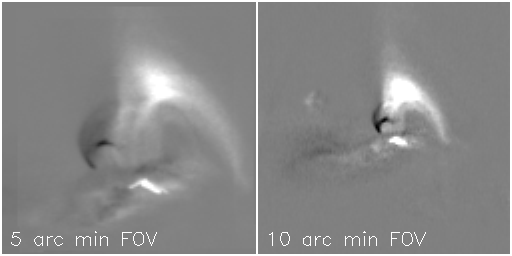Introduction
Two X-class flares occurred during the week just prior to the Yohkoh data vacation. We look at the one from December 11 in this science nugget. As often happens, Nature conspired (see Figure 1) to deprive us of direct observations of the interesting flare event itself; the spacecraft was in orbit night and then in the Van Allen belts. That was the case for both of these X-class flares. However (and this is one of Yohkoh's modest discoveries, "dimming" often can be seen in soft X-rays by comparison of images made before and after the event. We will do that here. For background on dimming, which shows the soruce of at least some of the mass needed for a CME (Coronal Mass Ejection), see this nugget for example.
Morphology of the dimming
Figure 2 shows two sets of before-and-after images, one taken from the Yohkoh partial-frame images, and one taken from the full-frame images (time separation about 3h 25m). It is clear that the apparent connectivities of the loops visible in the pre-flare active region and in the flare loops are different, even though some of the footpoints seem to match. Theoretically, we don't expect footpoints actually to move much in such a short time interval; even for a rapid 1 km/s photospheric motion, the footpoints would be dragged by only 3 or 1.5 pixels, respectively, at the resolutions shownin Figure 2. We are always interested in tracking field lines as the corona restructures for a flare or a CME.
Now let us look at the difference images (Figure 3):
| Figure 3. Timewise difference images: left, higher resolution; right, lower resolution (note: let's look some time at the TRACE data for this event!) |  |
These show clear before-and-after differences (a lot) but also suggest that some structures have "kept their footing" during the event; it is a somewhat questionable concept theoretically, but for such structures we can think of these as the same field lines at least within our resolution. It is better perhaps to see these differences as movies, so we have prepared four of them, each with two frames each:
| High resolution, linear | High resolution, log-compressed |
| Low resolution, linear | Low resolution, log-compressed |
These movies are best seen in an MPEG player that allows one to stop action. They should make clear the identification of some of the structures; for example the right-hand part of the cusped arcade seems to match the same envelope before and after; also some footpoints on the left also seem to match. Interestingly, the low-resolution compressed movie shows changes in the active-region structure to the left of the flare position. It is a dimming, but the movie shows that it is also a displacement.
Probably the most intersting feature of the before-and-after comparisons is what Figure 4 shows:
Conclusions
Of course one can't learn anything conclusive from a single event, although we often make that claim. Carrington, who observed the first solar flare and was struck by what we'd call its geoeffectiveness, proclaimed "One swallow does not make a summer," certainly good advice. But this event nicely illustrates what we must do to be able to talk seriously about theories of solar flares and CMEs, namely to characterize the geometry of the field with great precision. That is why SOLAR-B, to be launched in 2005, will be such an important mission for flare research.
Footnote: The December 13 flare - the other one - started from a beautiful reverse sigmoid configuration!
H. Hudson (hudson@isass1.solar.isas.ac.jp)